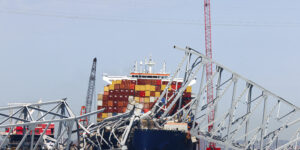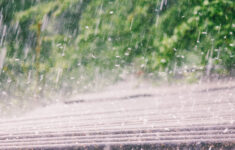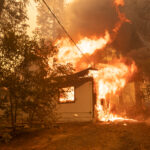Hurricane Idalia was strengthening on Tuesday as it lumbered toward Florida’s Gulf Coast, where officials ordered evacuations and urged millions of residents to brace for a possible major Category 3 storm when it makes landfall on Wednesday.
Idalia was expected to attain sustained winds in excess of 111 mph (179 kph) on Wednesday morning before slamming ashore later in the day, according to the Miami-based National Hurricane Center (NHC).
Florida Governor Ron DeSantis urged residents in low-lying areas to heed orders to seek higher ground, warning that the storm surge could cause life-threatening floods.
“If you are told to evacuate, you have to do that now,” he said at a Tuesday morning news briefing. Evacuation orders have been issued in 22 counties, and more than 20 emergency shelters have been opened, he said.
The NHC projected Idalia’s center would likely cross Florida’s coastline somewhere in the Big Bend region, where the state’s northern panhandle curves around into the Gulf side of the Florida Peninsula. The area, roughly between the inland cities of Tallahassee and Gainesville, is much more lightly populated than the Tampa-St. Petersburg area to the south.
Despite the latest projection, the path of the intensifying storm was uncertain as it spun northward over the warm waters of the Gulf of Mexico, a day after passing just west of Cuba, where tens of thousands evacuated ahead of flooding and high winds.
Idalia intensified into a hurricane early on Tuesday. It was expected to reach Category 3 force – classified as a major hurricane – on the five-step Saffir-Simpson wind scale by the time it makes Florida landfall on Wednesday, the NHC said.
SURGES UP TO 12 FEET HIGH
Most of Florida’s 21 million residents, along with those in the southern Georgia and South Carolina, were under hurricane, tropical storm and storm surge warnings and advisories.
From Tuesday through Thursday, Florida’s Gulf Coast along with southeastern Georgia and eastern portions of North and South Carolina could face torrential rains of 4 to 8 inches (10 to 20 cm), in addition to tidal inundation from storm surges, the hurricane center warned.
Idalia’s chief threat to human life stemmed from surging walls of seawater driven inland by high winds, inundating low-lying coastal areas, authorities said.
Surge warnings were posted for hundreds of miles of shoreline, from Sarasota in the north through Tampa and stretching to the sport fishing haven of Indian Pass at the western end of Apalachicola Bay.
In some spots, the surge of water could rise 8 to 12 feet (2.5-3.7 m), the hurricane center said.
“The No. 1 killer in all of these storms is water,” Deanne Criswell, the Federal Emergency Management Agency’s administrator, said on CNN on Tuesday.
St. Petersburg residents living in areas prone to flooding were urged to leave by Tuesday afternoon, the city’s police chief Anthony Holloway said on CNN.
More than 40 school districts across the region canceled classes, DeSantis said. Tampa International Airport planned to suspend commercial operations beginning at midday Tuesday.
Some 5,500 National Guard troops were mobilized and between 30,000 and 40,000 electricity workers were standing by to help restore power quickly after the hurricane passes.
Idalia will be the fourth major hurricane to strike Florida over the past seven years, following Irma in 2017, Michael in 2018 and Ian, which peaked at Category 5, last September.
By midmorning on Tuesday, Idalia was churning about 320 miles (515 km) southwest of Tampa as it crept northward, packing maximum sustained winds of 80 mph (130 kph).
BRUSH WITH CUBA
As Floridians were scrambling for Idalia’s arrival, Cubans were grappling with the aftermath of the storm, which lingered for hours on Monday near the western end of the Caribbean island nation.
By mid-afternoon, brown floodwaters had swamped the small fishing village of Guan, one hour’s drive south of Havana.
Decades-old buses missing floorboards and windows carried women and children to higher ground as winds howled, rattling tin roofs and slamming fishing boats tucked in the mangroves.
“We’ve had two days of rain already,” said Yadira Alvarez, 34, as she readied for evacuation with her five children. “We try to prepare, but no matter what we do everything will be soaked.”
Stormwater had already swelled to near knee-height inside her home, she said.
Farther to the west, more intense winds closer to the storm center pounded the tobacco-rich province of Pinar del Rio, home to the raw material for some of the world’s finest Cuban cigars.
Authorities evacuated tens of thousands of people from that province as well as neighboring Artemisa, while squalls of heavy rain doused the Cuban capital of Havana.




















 Fla. Regulators’ Effort to Remove Insurer Execs May Not Pass Constitutional Muster
Fla. Regulators’ Effort to Remove Insurer Execs May Not Pass Constitutional Muster  P/C Insurance Execs, Underwriters Out of Sync on Advanced Tech
P/C Insurance Execs, Underwriters Out of Sync on Advanced Tech  As Wildfire Risk Grows, States Grapple to Retain Property Insurers
As Wildfire Risk Grows, States Grapple to Retain Property Insurers  Allstate Will Insure California Homes Again, Under One Condition
Allstate Will Insure California Homes Again, Under One Condition 



